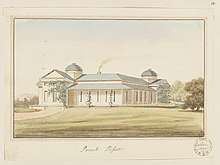John Piper (military officer)
John Piper (20 April 1773 – 8 June 1851) was a military officer, public servant and landowner in the colony of New South Wales. The Sydney suburb of Point Piper was named in his honour.


John Piper | |
|---|---|
 Captain John Piper, c.1826, oil painting by Augustus Earle | |
| Born | 20 April 1773 Maybole, Ayrshire Scotland |
| Died | 8 June 1851 (aged 78) near Bathurst, New South Wales |
| Allegiance | United Kingdom/Australia |
| Service/ | New South Wales Corps |
| Years of service | April 1791 – 1811 (20 years) |
| Rank | Captain |
| Commands held |
|
| Spouse(s) | Mary Ann Shears |
| Children | 14 |
| Other work |
|
Background
Piper was born in Maybole, Ayrshire Scotland, son of Hugh Piper, a doctor; his family came from Cornwall.
Military career
He was commissioned as an ensign in the New South Wales Corps in 1791, and sailed on the convict ship Pitt, arriving in Sydney in February 1792. In 1793 he was sent, at his own request, to the convict settlement of Norfolk Island, perhaps because of a scandalous love affair. There was certainly an illegitimate daughter born around this time.[1][2]
Piper was promoted lieutenant and returned to Sydney in 1795; from 1797 to 1799 he was on leave.[2] In 1800 Piper was promoted to the local rank of captain. Piper supported John Macarthur in the struggle between the New South Wales Corps and Governor King, and acted as his second in a duel with Colonel Paterson, his commanding officer. Piper was arrested and court-martialled in 1802, but apologised and was acquitted, to King's disgust.[2]
Piper returned to Norfolk Island in 1804 and, when Lieutenant-Governor Joseph Foveaux left on prolonged sick leave, became acting commandant. His rule was mild, one of the convicts later writing that he "had the good will and respect of everyone, for he had always conducted himself as a Christian and a gentleman." He was promoted to the full rank of captain in 1806. During Piper's period of leadership on Norfolk Island the British government decided it was too costly to maintain, and planned to close the settlement and transfer the inhabitants to Sydney or Van Diemen's Land. Piper showed both tact and organising ability in arranging for the transfers, especially of those settlers who had built up farms and families on the island.[1]
Piper returned to Sydney in 1810, having avoided all the turmoil of the Rum Rebellion. He sailed for England in 1811, but resigned his commission and returned to Sydney in February 1814, as Naval Officer.
Administrative career
In 1816 he married Mary Ann Shears, the daughter of two First Fleet convicts, who had already borne several children by him.[1]
As Naval Officer, Piper was responsible for the collection of customs duties, excise on spirits, harbour dues, control of lighthouses, and crime on water. This post proved very remunerative, and he was able to purchase the property now known as Vaucluse House. He was granted 77 hectares (190 acres) on what is now Point Piper and built Henrietta Pavilion at the large cost of £10,000. He was appointed a magistrate by Governor Macquarie in 1819, was chairman of directors of the Bank of New South Wales, sat on the local committee of the Australian Agricultural Co., was president of the Scots Church committee, and was involved in many social and sporting activities. As well as Point Piper he had 192 hectares (475 acres) at Vaucluse, 460 hectares (1,130 acres) at Woollahra and Rose Bay, a farm of 119 hectares (295 acres) at Petersham, 280 hectares (700 acres) at Neutral Bay, 32 hectares (80 acres) at Botany Bay, 810 hectares (2,000 acres) at Bathurst, 120 hectares (300 acres) in Van Diemen's Land, and an zero point four zero hectares (one acre) of commercial land in George Street, Sydney.[1]
Piper however, had financial difficulties; in 1826 he raised a mortgage of £20,000. He was forced to resign his bank chairmanship after an enquiry into its affairs in January 1827, and that April was suspended from his position as Naval Officer when mismanagement of customs collection was discovered. Piper unsuccessfully tried to drown himself, and was forced to sell most of his property to repay his debts in full. Piper retired to his farm at Bathurst and became an important person in the town, but was forced to mortgage the property in the drought of 1838. Piper was saved by his friends who re-established the family to a property beside the Macquarie River. Here Piper died on 8 June 1851, and Mary Ann continued to live until her death twenty years later, supported by her numerous children.[1]
Marjorie Barnard claims that "John Piper was a man of his times. He personified the colonial dream." He was an officer during the military rule, a civil servant when New South Wales became a civil state, and a land pioneer during the pastoral age. "He was honourable, generous, gay and so well loved that he was forgiven things which would have wrecked a stronger man. … He was a master of the bright illusion."[2]
References
- Serle, Percival (1949). "Piper, John". Dictionary of Australian Biography. Sydney: Angus and Robertson. Retrieved 19 October 2008.
- Barnard, Marjorie (1967). "Piper, John (1773–1851)". Australian Dictionary of Biography. Melbourne University Press. ISSN 1833-7538. Retrieved 6 November 2009 – via National Centre of Biography, Australian National University.
Bibliography
- Hazzard, Margaret (1984). Punishment Short of Death: a history of the penal settlement at Norfolk Island. Melbourne: Hyland.
Further reading
| Wikimedia Commons has media related to Vaucluse House. |
- Eldershaw, M. Barnard; Feint, Adrian (illustrator) (1973). The life and times of Captain John Piper. Ure Smith in association with the National Trust of Australia (N.S.W.). ISBN 072540132X.CS1 maint: multiple names: authors list (link)